Intel Core i7 3960X (Sandy Bridge E) Review: Keeping the High End Alive
by Anand Lal Shimpi on November 14, 2011 3:01 AM EST- Posted in
- CPUs
- Intel
- Core i7
- Sandy Bridge
- Sandy Bridge E
Windows 7 Application Performance
3dsmax 9
Today's desktop processors are more than fast enough to do professional level 3D rendering at home. To look at performance under 3dsmax we ran the SPECapc 3dsmax 8 benchmark (only the CPU rendering tests) under 3dsmax 9 SP1. The results reported are the rendering composite scores.
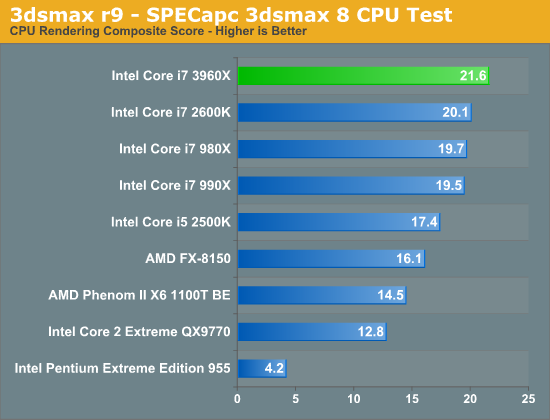
Offline 3D rendering applications make some of the best use of CPU cores, unfortunately our test here doesn't scale all that well. We only see a 7% increase over the 2600K. If we look at a more modern 3D workload however...
Cinebench 11.5
Created by the Cinema 4D folks we have Cinebench, a popular 3D rendering benchmark that gives us both single and multi-threaded 3D rendering results.
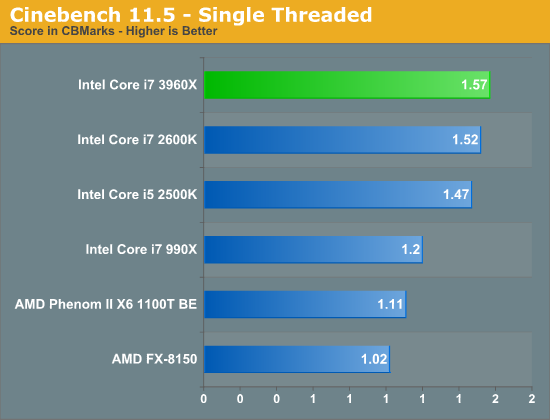
Single threaded performance is marginally better than the 2600K thanks to the 3960X's slightly higher max turbo speed. What's more important than the performance here is the fact that the 3960X is able to properly power gate all idle cores and give a single core full reign of the chip's TDP. Turbo is alive and well in SNB-E, just as it was in Sandy Bridge.
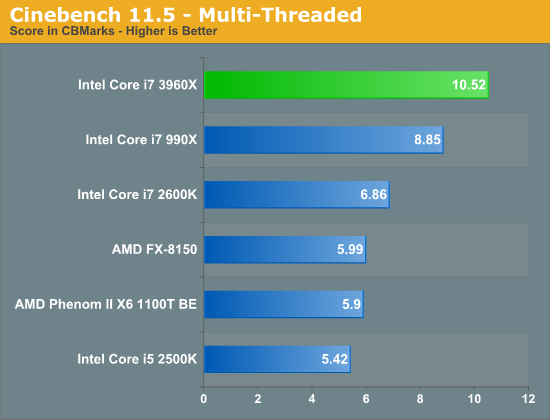
Here the performance gains are staggering. The 3960X is 53% faster than the 2600K and 19% faster than Intel's previous 6-core flagship, the 990X. The Bulldozer comparison is almost unfair, the 3960X is 75% faster (granted it is also multiple times the price of the FX-8150).
7-Zip Benchmark
While Cinebench shows us multithreaded floating point performance, the 7-zip benchmark gives us an indication of multithreaded integer performance:

Here we see huge gains over the 2600K (58%), indicating that the increase in cache size and memory bandwidth help the boost in core count a bit here. The advantage over the 990X is only 7%. This gives us a bit of a preview of what we can expect from SNB-EP Xeon server performance.
PAR2 Benchmark
Par2 is an application used for reconstructing downloaded archives. It can generate parity data from a given archive and later use it to recover the archive
Chuchusoft took the source code of par2cmdline 0.4 and parallelized it using Intel’s Threading Building Blocks 2.1. The result is a version of par2cmdline that can spawn multiple threads to repair par2 archives. For this test we took a 708MB archive, corrupted nearly 60MB of it, and used the multithreaded par2cmdline to recover it. The scores reported are the repair and recover time in seconds.
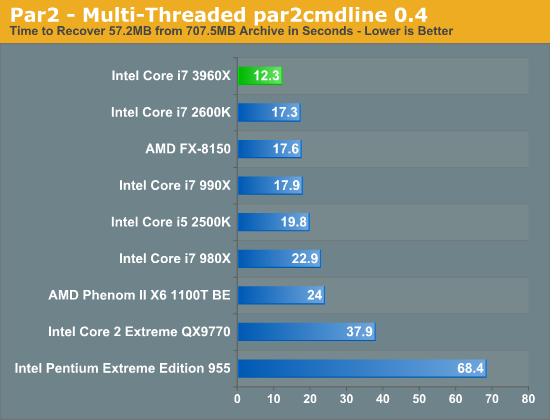
Here we see a 40% increase in performance over the 2600K and FX-8150.
TrueCrypt Benchmark
TrueCrypt is a very popular encryption package that offers full AES-NI support. The application also features a built-in encryption benchmark that we can use to measure CPU performance with:
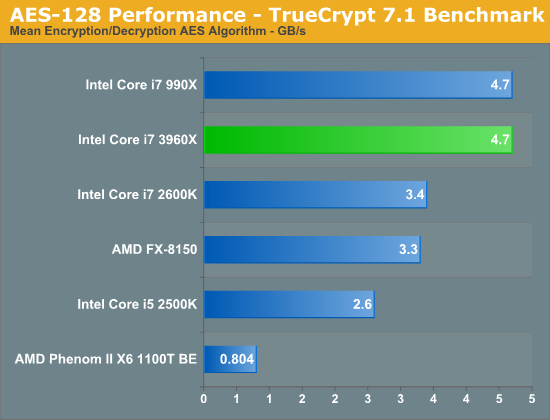
As both the 990X and 3960X have AES-NI support, both are equally capable at cranking through an AES workload. Per core performance doesn't appear to have changed all that much with the move to Sandy Bridge, so here we have a situation where the 3960X is much faster than the 2600K but no faster than the 990X. I suspect these types of scenarios will be fairly rare.
x264 HD 3.03 Benchmark
Graysky's x264 HD test uses x264 to encode a 4Mbps 720p MPEG-2 source. The focus here is on quality rather than speed, thus the benchmark uses a 2-pass encode and reports the average frame rate in each pass.
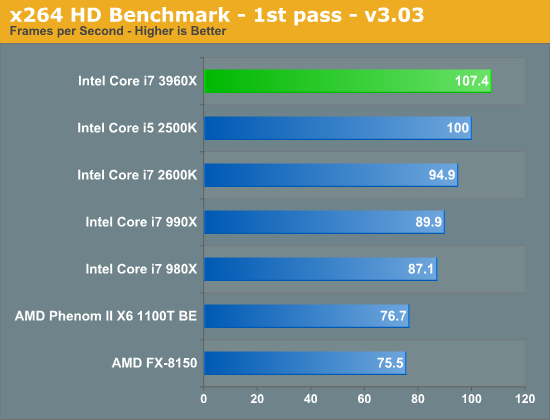
Single threaded performance isn't significantly faster than your run-of-the-mill Sandy Bridge, which means the first x264 HD pass doesn't look all that impressive on SNB-E.
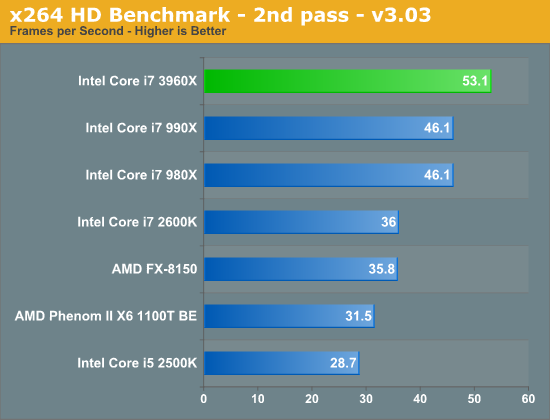
The second pass however stresses all six cores far more readily, resulting in a 47.5% increase in performance over the 2600K. Even compared to the 990X there's a 15% increase in performance.
Adobe Photoshop CS4
To measure performance under Photoshop CS4 we turn to the Retouch Artists’ Speed Test. The test does basic photo editing; there are a couple of color space conversions, many layer creations, color curve adjustment, image and canvas size adjustment, unsharp mask, and finally a gaussian blur performed on the entire image.
The whole process is timed and thanks to the use of Intel's X25-M SSD as our test bed hard drive, performance is far more predictable than back when we used to test on mechanical disks.
Time is reported in seconds and the lower numbers mean better performance. The test is multithreaded and can hit all four cores in a quad-core machine.
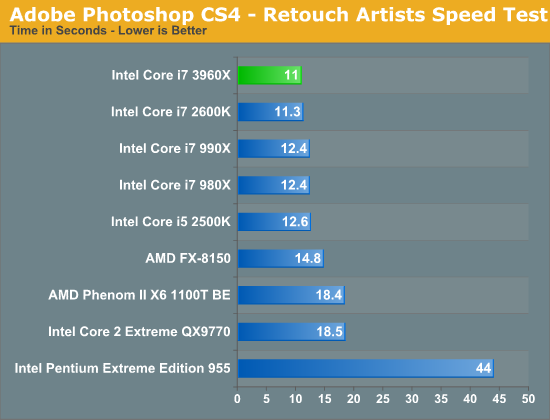
Our Photoshop test is multithreaded but there are only spikes that use more than four cores. That combined with the short duration of the benchmark shows no real advantage to the 3960X over the 2600K. Sandy Bridge E is faster than Intel's old 6-core solution though.
Compile Chromium Test
You guys asked for it and finally I have something I feel is a good software build test. Using Visual Studio 2008 I'm compiling Chromium. It's a pretty huge project that takes over forty minutes to compile from the command line on the Core i3 2100. But the results are repeatable and the compile process will stress all 12 threads at 100% for almost the entire time on a 980X so it works for me.
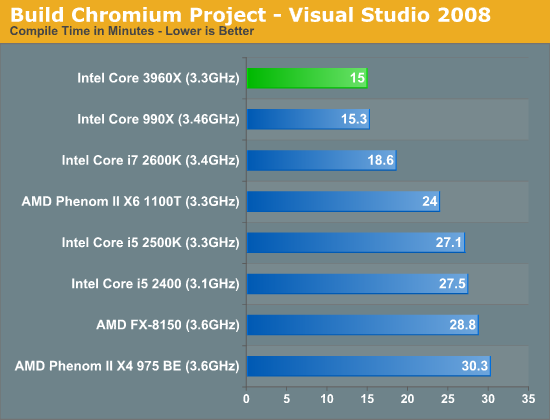
Our compile test is extremely well threaded, which once again does well on the 3960X. The gains aren't as big as what we saw in some of our earlier 3D/transcoding tests, but if you're looking to build the fastest development workstation you'll want a Sandy Bridge E.
Excel Monte Carlo
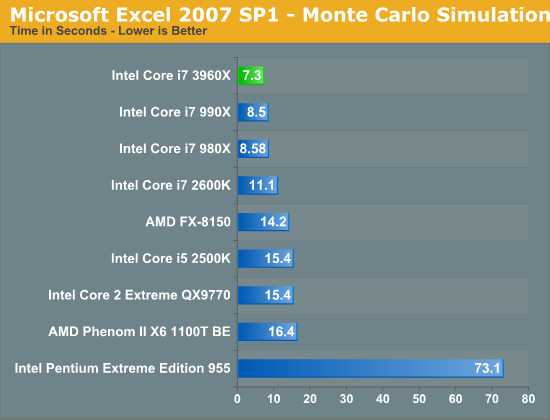
Multithreaded compute does well on SNB-E regardless of the type of application. Excel is multithreaded and if you have a beefy enough workload, you'll see huge gains over the 2600K.










163 Comments
View All Comments
xpclient - Monday, November 14, 2011 - link
I read Intel is not going to release AHCI/SATA/Matrix RAID drivers for 32-bit Windows XP for X79. Why??? Without AHCI, performance is going not going to be optimal. For those that dual boot with Windows 7, this means changing the settings from AHCI to IDE every time you boot into XP.Rick83 - Monday, November 14, 2011 - link
And I heard that USB 3 had no drivers for my Win95 D either!B3an - Monday, November 14, 2011 - link
Because no one in there right mind would buy this high-end platform then use a decade old POS operating system. Waste of Intels time to support it and XP needs to die already.XP will take little advantage of SSD's or even new HDD's properly, some drives wont even work at all on it, and it lacks the same level of support and performance for CPU features and multiple cores that Win7 has. If you really need to run some old software just use XP mode in Win 7 or use VM software.
xpclient - Monday, November 14, 2011 - link
Are you not aware of multi-core benchmarks? http://www.infoworld.com/t/platforms/generation-ga... Windows 7 does not perform faster than XP until you reach eight cores or higher.Peskarik - Monday, November 14, 2011 - link
"Just as with previous architectures, installing fewer DIMMs is possible, it simply reduces the peak available memory bandwidth."So, I have:
Asus P8Z68-V Pro/Gen3 motherboard
Intel Core i7 2600K
Corsair Vengeance Red, 2x4GB, DDR3-1600, CL9@1.5V
When I am in BIOS the memory is set to 1333Mhz, and I had to manually set it to 1600, though I am not sure whether it actually runs at this speed (how can I check?).
Does the above sentence from the article mean that with 8GB RAM I do not have full memory bandwidth and that if I install 16GB RAM (I have 4 slots) then I have full 1600Mhz automatically?
kr1s69 - Monday, November 14, 2011 - link
Sandy Bridge E is quad channel and so needs 4 DIMM's to obtain the peak bandwidth. Your Sandy Bridge system is dual channel and so you need 2 DIMM's to obtain the peak bandwidth. This is what you currently have installed, so no need to worry.The statement you quoted is basically saying this motherboard would boot with less than 4 DIMM's installed, that is all.
Sandy Bridge defaults to 1333Mhz but you can change this in the BIOS to 1600Mhz as you have done. You can download CPU-Z to confirm what speed your RAM is set to.
piroroadkill - Monday, November 14, 2011 - link
Set the O/C Profile to X.M.P.This uses the eXtreme Memory Profile provided by your RAM. Basically, standard SPD ratings don't go as high as 1600. XMP is required for this, it's a custom Intel extension to SPD.
piroroadkill - Monday, November 14, 2011 - link
Although it's supposed to work, in my experience I had to set my RAM to DDR3-1600 anyway. Ho hum.lukarak - Monday, November 14, 2011 - link
This is not a great update. I wonder if 2011 will be the socket for ivy bridge E. If that's the case, it could be a good buy for somebody transitioning from an older system.dlitem - Monday, November 14, 2011 - link
There were some rumors / news circulating earlier that VT-d is bugged. Is that actually the case? SB-E is The workstation platform and losing VT-d is kind of a shame, as there actually are people who might have benefited from it.Also, a lot of us are still running our trusty 3 year old Quad-Bloomfields that have served us so well, so including one LGA1366 Quad-core would have be a really nice thing.